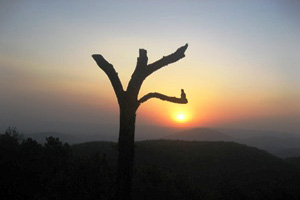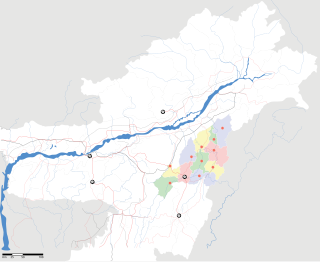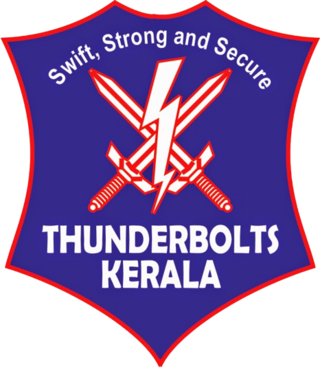
Guerrilla warfare is a form of unconventional warfare in which small groups of irregular military, such as rebels, partisans, paramilitary personnel or armed civilians including recruited children, use ambushes, sabotage, terrorism, raids, petty warfare or hit-and-run tactics in a rebellion, in a violent conflict, in a war or in a civil war to fight against regular military, police or rival insurgent forces.

A low-intensity conflict (LIC) is a military conflict, usually localised, between two or more state or non-state groups which is below the intensity of conventional war. It involves the state's use of military forces applied selectively and with restraint to enforce compliance with its policies or objectives.

The Indo-Tibetan Border Police (ITBP) is a border guarding force of India deployed along its borders with Tibet Autonomous Region. It is one of the seven Central Armed Police Forces, established in 1962 in the aftermath of the Sino-Indian War of 1962.

Jungle warfare or woodland warfare is warfare in forests, jungles, or similar environments. The term encompasses military operations affected by the terrain, climate, vegetation, and wildlife of densely-wooded areas, as well as the strategies and tactics used by military forces in these situations and environments.

Netarhat is a hill station in Latehar district in the Indian state of Jharkhand. It is also referred to as the "Queen of Chotanagpur", and is a hill station. The town is also famous for Netarhat Residential School, set up in 1954.

Counterinsurgency is "the totality of actions aimed at defeating irregular forces". The Oxford English Dictionary defines counterinsurgency as any "military or political action taken against the activities of guerrillas or revolutionaries" and can be considered war by a state against a non-state adversary. Insurgency and counterinsurgency campaigns have been waged since ancient history. However, modern thinking on counterinsurgency was developed during decolonization.

Vairengte is a town in the Kolasib district of Mizoram state, India.

The Marine Commandos, abbreviated to MARCOS and officially called the Marine Commando Force (MCF), are the special forces of the Indian Navy. The MARCOS were originally named Indian Marine Special Force, which was later changed to Marine Commando Force to impart "an element of individuality" to it, according to the Indian Navy. The abbreviation 'MARCOS' was coined afterwards.
The Indian Defence services have established numerous academies and staff colleges across India for the purpose of training professional soldiers in military sciences, warfare command and strategy, and associated technologies.

Para (Special Forces), also known as Para Commandos or Para (SF) Commandos, is a group of special forces battalions of the Parachute Regiment in the Indian Army. These units specialize in various roles including counter-terrorism, hostage rescue, unconventional warfare, special reconnaissance, counter-insurgency and direct action.

The Garud Commando Force is the special forces unit of the Indian Air Force. It was formed in September 2004 and has a current strength of over 1500 personnel. The unit derives its name from Garuda, a Hindu God.

The insurgency in Nagaland, in northeastern India, is an ongoing conflict fought between the ethnic Nagas and the governments of India. Nagaland inhabited by the Nagas is located at the tri-junction border of India on the West and South, north and Myanmar on the East.
Ghatak Platoons are special operations capable reconnaissance platoons present in every infantry battalion of the Indian Army. Ghatak is a Sanskrit word meaning "killer" or "lethal". Their name was given to them by General Bipin Chandra Joshi. They act as shock troops and spearhead assaults ahead of the battalion.

Sashastra Seema Bal is a border guarding force of India deployed along its borders with Nepal and Bhutan. It is one of the seven Central Armed Police Forces under the administrative control of the Ministry of Home Affairs (MHA).

The High Altitude Warfare School (HAWS) is a defence service training and research establishment of the Indian Army. In 1948, the Indian Army established a ski school in Gulmarg that later became the High Altitude Warfare School, which specialises in snow–craft and winter warfare. It is located in an area which is prone to avalanches. Selected soldiers from the US, UK, Germany and other countries visit regularly for specialist training.

COBRA is a special operation unit of the Central Reserve Police Force (CRPF) of India proficient in guerrilla tactics and jungle warfare. Originally established to counter the Naxalite movement, CoBRA is deployed to address insurgent groups engaging in asymmetrical warfare. Numbering ten battalions as of 2011, CoBRA is considered to be one of the most experienced and successful law enforcement units in the country.

Kerala Thunderbolts is an elite commando force of the Kerala Police under the India Reserve Battalion, set up in accordance with the Indian central government's directions post the 2008 Mumbai attacks. The commando force has been created to counter possible terror strikes and carry out counterinsurgency operations in Kerala. The force modeled on the Special Protection Group and National Security Guard are trained to engage in air, water and land attacks.

The communist insurgency in Sarawak was an insurgency in Malaysia from 1962 to 1990, and involved the North Kalimantan Communist Party and the Malaysian Government. It was one of the two Communist insurgencies to challenge the former British colony of Malaysia during the Cold War. As with the earlier Malayan Emergency (1948–1960), the Sarawak Communist insurgents were predominantly ethnic Chinese, who opposed British rule over Sarawak and later opposed the merger of the state into the newly created Federation of Malaysia. The insurgency was triggered by the 1962 Brunei Revolt, which had been instigated by the left-wing Brunei People's Party in opposition to the proposed formation of Malaysia.
Lieutenant General Joginder Singh Bakshi MVC, VSM was a General Officer in the Indian Army. He was decorated with the Maha Vir Chakra for his role in the Indo-Pakistani War of 1971.

Edavelath Nalamveetil Rammohan was an Indian Police Service (IPS) officer of the 1965 batch, who served in many of India’s police and paramilitary organisations. He retired as Director General (DG) of the Border Security Force (BSF), a leading paramilitary force of India, tasked with guarding the country’s borders.

















